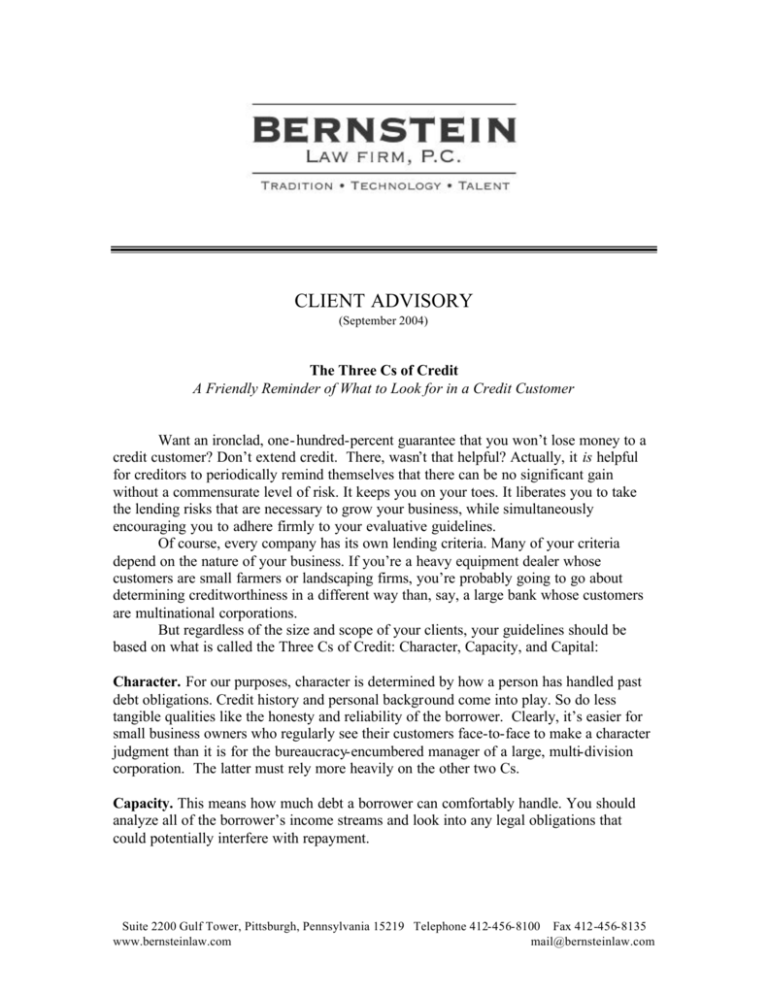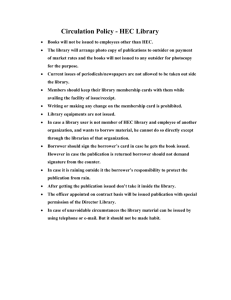
CLIENT ADVISORY
(September 2004)
The Three Cs of Credit
A Friendly Reminder of What to Look for in a Credit Customer
Want an ironclad, one- hundred-percent guarantee that you won’t lose money to a
credit customer? Don’t extend credit. There, wasn’t that helpful? Actually, it is helpful
for creditors to periodically remind themselves that there can be no significant gain
without a commensurate level of risk. It keeps you on your toes. It liberates you to take
the lending risks that are necessary to grow your business, while simultaneously
encouraging you to adhere firmly to your evaluative guidelines.
Of course, every company has its own lending criteria. Many of your criteria
depend on the nature of your business. If you’re a heavy equipment dealer whose
customers are small farmers or landscaping firms, you’re probably going to go about
determining creditworthiness in a different way than, say, a large bank whose customers
are multinational corporations.
But regardless of the size and scope of your clients, your guidelines should be
based on what is called the Three Cs of Credit: Character, Capacity, and Capital:
Character. For our purposes, character is determined by how a person has handled past
debt obligations. Credit history and personal background come into play. So do less
tangible qualities like the honesty and reliability of the borrower. Clearly, it’s easier for
small business owners who regularly see their customers face-to-face to make a character
judgment than it is for the bureaucracy-encumbered manager of a large, multi-division
corporation. The latter must rely more heavily on the other two Cs.
Capacity. This means how much debt a borrower can comfortably handle. You should
analyze all of the borrower’s income streams and look into any legal obligations that
could potentially interfere with repayment.
Suite 2200 Gulf Tower, Pittsburgh, Pennsylvania 15219 Telephone 412-456-8100 Fax 412-456-8135
www.bernsteinlaw.com
mail@bernsteinlaw.com
Capital. You must have a firm grasp on the current available assets of the borrower, such
as real estate holdings, savings, or investments that could be used to repay debt if income
should be unavailable.
You should make certain that your risk assessment protocol takes all three Cs into
account. Then, incorporate the spirit of the Three Cs into all of your business practices.
This will help you keep your credit people and your salespeople—as well as all other key
players in your company—on the same page.
Do this and you can rest easy, secure in the knowledge that you’re making the
smartest possible lending decisions. If you have any questions about how to go about
more firmly entrenc hing the Three Cs into your credit policies, just call us. We are
always happy to help our clients become more confident and knowledgeable in all
relevant aspects of the law.
Editor’s Note:
•
We are pleased to announce that attorney Christopher Boback has joined
Bernstein Law Firm on our bankruptcy and litigation teams.
NOTE: Information contained herein is a summary of complicated matters. It is not intended to
convey legal advice. Before you act on any information provided in this document, you should
seek professional advice regarding its applicability to your specific circumstances ©2004, All
rights reserved.
Bernstein Law Firm, P.C. is a full-service commercial, creditors’ rights and bankruptcy
law firm, providing a comprehensive range of services in all aspects of creditor and
bankruptcy representation.
Suite 2200 Gulf Tower, Pittsburgh, Pennsylvania 15219 Telephone 412-456-8100 Fax 412-456-8135
www.bernsteinlaw.com
mail@bernsteinlaw.com












